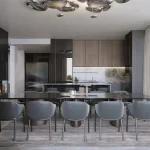Universal design in architecture, Pioneering accessible spaces for all, property development
Universal Design in Architecture – Pioneering Accessible Spaces for All
24 Oct 2023
Architecture transcends the mere construction of buildings; it’s about fashioning spaces where everyone can flourish. In the United Kingdom, the significance of universal design in architecture cannot be emphasised enough. This approach centres on fashioning spaces that are inclusive, ensuring accessibility for all, regardless of their physical abilities.
It’s about fostering environments accommodating individuals requiring mobility and disability aids. In this comprehensive exploration, we will delve into the concept of universal design and unravel how architects can seamlessly incorporate it into their projects, with a laser focus on illuminating real-world exemplars in the UK.
Grasping Universal Design
Universal design is the epitome of architectural inclusivity. It transcends the rudimentary requisites of accessibility and instead embraces a philosophy that strives to create welcoming and accommodating spaces for all.
At its core, universal design places an unwavering emphasis on flexibility, simplicity, and intuitive usability. Architects who adhere to these principles stand at the forefront of creating spaces that are not only accessible but also aesthetically captivating and exceptionally functional.
Concrete Instances
The British Museum:
The British Museum in London stands as a quintessential example of a public edifice that has wholeheartedly embraced universal design. Ramps and elevators gracefully traverse its expanse, ensuring that visitors with mobility aids can peruse its extensive collections with seamless ease. Furthermore, tactile maps and audio guides transform the visit into a multisensory adventure catering to all visitors.
The Sackler Crossing, Kew Gardens:
Nestled within the verdant Royal Botanic Gardens at Kew, the Sackler Crossing is a stately footbridge that invites visitors of all abilities to partake in the splendours of lush landscapes. The bridge’s gentle slope and the strategic use of contrasting materials provide invaluable guidance for those with visual impairments. It is a testament to the notion that functional design can be elegantly integrated into the bosom of natural beauty.
Maggie’s Centres:
Designed by renowned architects, Maggie’s Centres offer solace and support to those grappling with cancer, all within a comforting environment. These architectural marvels are not only aesthetically breathtaking but also profoundly accessible to individuals with mobility challenges. With wide doorways, ramps, and open layouts, they ensure that all visitors can effortlessly access the vital services offered.
Tate Modern Switch House:
The extension of the Tate Modern in London, known as the Switch House, has been meticulously designed with an unwavering focus on accessibility. Boasting ramps, tactile guides, and accessible restrooms, it sets a soaring standard for public art spaces in the UK.
Embedding Universal Design in Architectural Projects
Integrating universal design principles into architectural endeavours is a nuanced and multifaceted process. Architects play a pivotal role in shaping the world around us, and when it comes to creating spaces that are truly accessible and inclusive, it requires a concerted effort. Below, we expand on practical steps architects can take to entrench universal design into their projects:
1. Collaboration: Fostering Accessibility Partnerships
Collaboration is the cornerstone of inclusive architectural design. Architects should actively seek partnerships with accessibility experts and, more crucially, engage individuals with disabilities during the design process.
Their lived experiences offer invaluable insights that can shape designs in profoundly meaningful ways. Involving them from project inception can help identify specific challenges and unique solutions tailored to the needs of diverse user groups.
2. Embracing Technological Advancements: Building Information Modeling (BIM)
The advent of technology has significantly enhanced the capabilities of architects. Embracing Building Information Modeling (BIM) software is a vital step. BIM enables architects to simulate and test designs for accessibility, providing a visual and data-driven representation of the space. Through BIM, architects can evaluate various design elements, including ramp gradients, door widths, and spatial layouts, making it a powerful tool for ensuring accessibility from the planning stage.
3. Integrating Adaptive Technology
In the age of smart buildings, architects should consider integrating adaptive technologies that cater to individuals with mobility challenges. Automated doors, for example, offer not only convenience but also independence to those using mobility aids.
Adjustable lighting systems can enhance visibility and create a more comfortable atmosphere for everyone. Furthermore, voice-activated controls empower users to interact with the environment seamlessly.
4. Education and Training: Nurturing a Culture of Universal Design
To make accessibility integral rather than an afterthought, architects must foster a culture of education and training within their profession. Continuous learning and understanding of universal design principles are essential.
Architects should attend workshops, seminars, and courses that focus on accessibility. Furthermore, they can encourage colleagues, teams, and design firms to cultivate an awareness of the principles of universal design. This ensures that the practice becomes second nature and remains at the forefront of their designs.
5. Periodic Audits and Ongoing Improvements
The commitment to accessibility doesn’t conclude with project completion. Architects should commit to regular accessibility audits to assess and refine their designs. These audits are crucial for pinpointing areas where improvements can be made, whether in existing structures or upcoming projects.
They also serve as a mechanism for compliance with evolving accessibility regulations, which may change over time. Maintaining vigilance in this regard ensures that architectural designs remain relevant and accommodating.
Pioneering accessible spaces for all – In Closing
Universal design in architecture transcends being a mere legal obligation; it embodies a moral and ethical responsibility for architects and designers in the UK. By creating accessible spaces that seamlessly integrate features like ramps, elevators, and wider doorways, architects contribute to enhancing the quality of life for individuals with mobility aids and disabilities.
The real-world examples in the UK underscore the profound reality that universal design can be both highly functional and aesthetically captivating, setting an enduring standard for the future of accessible architecture in the country.
Comments for this Universal Design in Architecture – Pioneering Accessible Spaces for All article are welcome.
Building Design
Artisan New Homes
Artisan Real Estate Developments
Artisan Real Estate Sustainable Homes
Property Developments
Architecture Developments
Springside Quarter Fountainbridge
Comments / photos for Universal Design in Architecture – Pioneering Accessible Spaces for All page are welcome.


